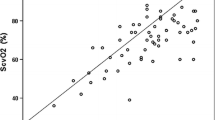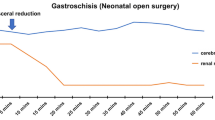Abstract
Clinical assessment of systemic perfusion in single ventricle patients with parallel circulation can be difficult in the outpatient setting. Near infrared spectroscopy (NIRS) is a noninvasive measure of cerebral oximetry. We measured vital signs, pulse oximetry, and NIRS in 20 single ventricle patients with parallel circulation prior to routine cardiac catheterization. These variables were evaluated to determine the best noninvasive predictor of the superior vena cava saturation (SVCsat) as a marker for the adequacy of systemic oxygen delivery. The mean age was 6.7 months [standard deviation (SD), 8.6] and mean weight was 6.5 kg (SD, 2.2). Diagnoses were hypoplastic left heart syndrome (8), tricuspid or pulmonary atresia (10), and double-outlet right ventricle variants (2), all prior to cavo pulmonary anastomoses or complete repairs. Stepwise multiple regression analysis generated a model in which only NIRS was a significant independent predictor of SVCsat (p = 0.009). These results support the conclusion that NIRS can be a useful tool to evaluate awake single ventricle patients in the outpatient setting.

Similar content being viewed by others
References
Abdul-Khaliq H, Troitzsch D, Schubert S, et al. (2002) Cerebral oxygen monitoring during neonatal cardiopulmonary bypass and deep hypothermic circulatory arrest. Thorac Cardiovasc Surg 50:77–81
Hoffman G, Tweddell J, Ghanayem N, et al. (2004) Alteration of the critical arteriovenous oxygen saturation relationship by sustained afterload reduction after the Norwood procedure. J Thorac Cardiovasc Surg 127:738–745
Rossi A, Sommer R, Lotvin A, et al. (1994) Usefulness of intermittent monitoring of mixed venous oxygen saturation after stage 1 palliation for hypoplastic left heart syndrome. Am J Cardio 73:1118–1123
Tortoriello T, Stayer S, Mott A, et al. (2005) A noninvasive estimation of mixed venous oxygen saturation using near-infrared spectroscopy by cerebral oximetry in pediatric cardiac surgery patients. Paediatr Anaesth 15:495–503
Tweddell J, Hoffman G, Fedderly R, et al. (1999) Phenoxybenzamine improves systemic oxygen delivery after the Norwood procedure. Ann Thorac Surg 67:l61–168
Author information
Authors and Affiliations
Corresponding author
Additional information
Paper presented at the 55th annual scientific session of the American College of Cardiology, Atlanta, GA, USA, March 2006
Rights and permissions
About this article
Cite this article
Kirshbom, P., Forbess, J., Kogon, B. et al. Cerebral Near Infrared Spectroscopy Is a Reliable Marker of Systemic Perfusion in Awake Single Ventricle Children. Pediatr Cardiol 28, 42–45 (2007). https://doi.org/10.1007/s00246-006-1389-x
Received:
Accepted:
Published:
Issue Date:
DOI: https://doi.org/10.1007/s00246-006-1389-x




